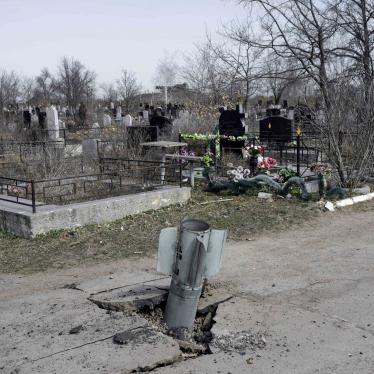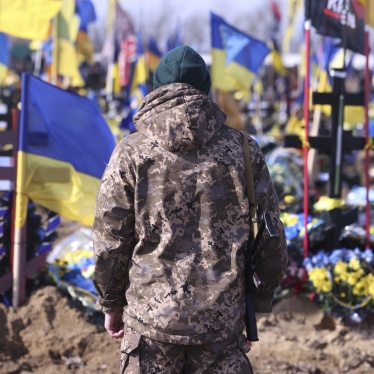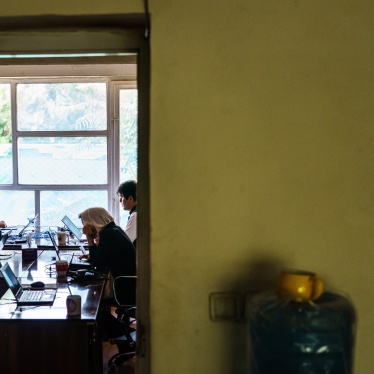Dear Minister,
I am writing on behalf of Human Rights Watch with respect to the ongoing cluster munition attacks in Syria and the Russian Federation’s role in those attacks, specifically to request that the Russian Federation publicly acknowledge its use of cluster munitions in Syria and refrain from using these indiscriminate weapons. We also encourage Russia to engage with Syrian government authorities to end Syria’s use of these indiscriminate weapons.
Human Rights Watch has documented extensive use of air-dropped and ground-launched cluster munitions in Syria since 2012, particularly since the Russian Federation began its joint operation with the Syrian government on September 30, 2015. There is compelling evidence that Russian government aircraft are being used to deliver cluster munitions and/or participate with Syrian government aircraft in attacks using cluster munitions.
Over the past 10 months Human Rights Watch has documented an increase in the use of cluster munitions on opposition-controlled territory in the governorates of Aleppo, Damascus, Idlib, Homs, and Hama. In the period from September 30, 2015—when Russia began its joint operation with Syrian government forces—until July 27, 2016, Human Rights Watch documented a total of 76 cluster munition attacks. The actual number is likely far higher.
In each case, we determined that an attack was carried out with cluster munitions only after obtaining visual confirmation of the type of cluster munition used.
These cluster munition attacks have killed and maimed scores of civilians, while the resulting unexploded ordnance (UXO) will continue to claim lives and limbs for years to come. Photographs and videos as well as reports from volunteer clearance teams in Syria show how hundreds of submunitions have failed to explode and pose a threat to civilians, particularly AO-2.5RT/RTM and ShOAB-0.5 submunitions from RBK-series bombs. We have documented numerous civilian casualties from the handling of unexploded submunitions, including children.
The Russian Federation has denied using cluster munitions in Syria in its joint military operation with Syrian government forces. Most recently, on December 23, 2015, the Ministry of Defense responded to a report by Amnesty International. We are not aware of, but would appreciate an official comment or response from the Russian Federation to the six reports detailing cluster munition attacks in Syria that Human Rights Watch has issued since October 10, 2015. (See Annex)
According to our research, SU-34 fighter-ground attack aircraft have participated in attacks delivering RBK-series cluster bombs in Syria. Locals also observed and filmed SU-25 fighter-ground attack aircraft flying near sites attacked with cluster munitions at the time of the attack. Only the Russian air force operates these types of Sukhoi fighter-ground attack aircraft in Syria. Video footage and photographs taken at Russia’s airbase at Hmeymim, southeast of Latakia City, show cluster munition mounted on these aircraft.
We also note that the Russian Ministry of Defense appeared to acknowledge responsibility for a June 16, 2016 attack on coalition-backed armed opposition forces near the Syrian al-Tanf border crossing with Iraq in a statement posted on its website. Photographs released by the forces attacked clearly show the presence of RBK-500 cluster munition remnants, including unexploded AO-2.5RT/RTM submunitions.
Human Rights Watch has also documented types of cluster munitions that were not used in the Syrian conflict until Russia began its joint military operation with Syria. Since October 2015, advanced air-dropped RBK-500 SPBE cluster bombs containing SPBE sensor fuzed submunitions have been used, while ground-launched 3-O-8 cluster munition projectiles containing O-10 submunitions have been used since December 2015.
Several air-dropped RBK-series cluster munitions used since September 30, 2015 bear markings showing they were produced from 1989 into the early 1990s, particularly the RBK-500 SPBE cluster bombs, which appear to have been manufactured in 1990 and 1991. This appears to be a noticeable shift from before the Russian intervention, when production markings on the cluster bombs used in Syria showed they were produced in the 1970s and 1980s.
We monitor and report on any use of cluster munitions by any actor in any country in our capacity as ban policy editor for the Cluster Munition Monitor initiative by the Cluster Munition Coalition. In Syria, we have also documented Islamic State (IS) use of cluster munition rockets, during its 2014 advance on Kobani. There is evidence that armed groups opposed to the Syrian government have repurposed unexploded submunitions as improvised explosive devices (IEDs). While we cannot determine with confidence if armed groups other than IS have used cluster munitions in Syria, none have been seen in possession of the systems necessary to deliver ground-launched cluster munitions, such as 9M79-series Tochka ballistic missiles with submunition warheads that have been used in Syria. Moreover, no other armed opposition group —IS included—operates aircraft in Syria.
We continue to monitor, but have seen no evidence to indicate that the US or its coalition partners in Operation Inherent Resolve have used cluster munitions against the IS forces in Syria and Iraq. On July 26, 2016, a spokesperson for the US Air Force told The Washington Post: “We have not employed cluster munitions in Operation Inherent Resolve. This includes both U.S. and coalition aircraft.”
Finally, we note Russia’s vote on December 7, 2015 against UN General Assembly Resolution 70/54 on the Convention on Cluster Munitions that 139 states voted to adopt. In its explanation of the vote, Russia expressed concern at the humanitarian impact caused by the “arbitrary use” of cluster munitions, but maintained that it does not agree with the approach taken by the 2008 treaty prohibiting these weapons.
We appreciated your November 6, 2015 letter responding to our inquiry on incendiary weapons, including its praise for our research and advocacy on these and other weapons in armed conflict around the world.
We are currently preparing new research on the cluster munition attacks in Syria and look forward to receiving a response by August 26, 2016.
We would also be pleased to discuss this letter with the Russian delegation to the Convention on Conventional Weapons at the upcoming preparatory meeting for the CCW’s Fifth Review Conference.
We look forward to hearing from you.
Sincerely,
Stephen D Goose
Executive Director, Arms Division, Human Rights Watch
Chair, Cluster Munition Coalition
Annex: Recent Human Rights Watch publications on cluster munitions in Syria
Reports
“Syria: New Russian-Made Cluster Munition Reported,” October 10, 2015.
“Russia/Syria: Extensive Recent Use of Cluster Munitions,” December 20, 2015.
“Cluster Munitions: A Year of Contradictions,” December 23, 2015.
“Russia/Syria: Daily Cluster Munition Attacks,” February 8, 2016.
“Syria: Great Danger to Civilians in Azaz,” February 18, 2016.
“Russia/Syria: Widespread New Cluster Munition Use,” July 28, 2016.
Commentaries
Mary Wareham, “Incendiary Weapons Pose Civilian Threat in Syria,” HRW Dispatch, June 21, 2016.
Ole Solvang, “Russian Cluster Munitions Have Literally Made Syria a Minefield,” The Moscow Times, 30 June 2016.
Mary Wareham, “Cluster Munitions Harm in Syria on Anniversary of the Ban,” Huffington Post, 1 August 2016.







